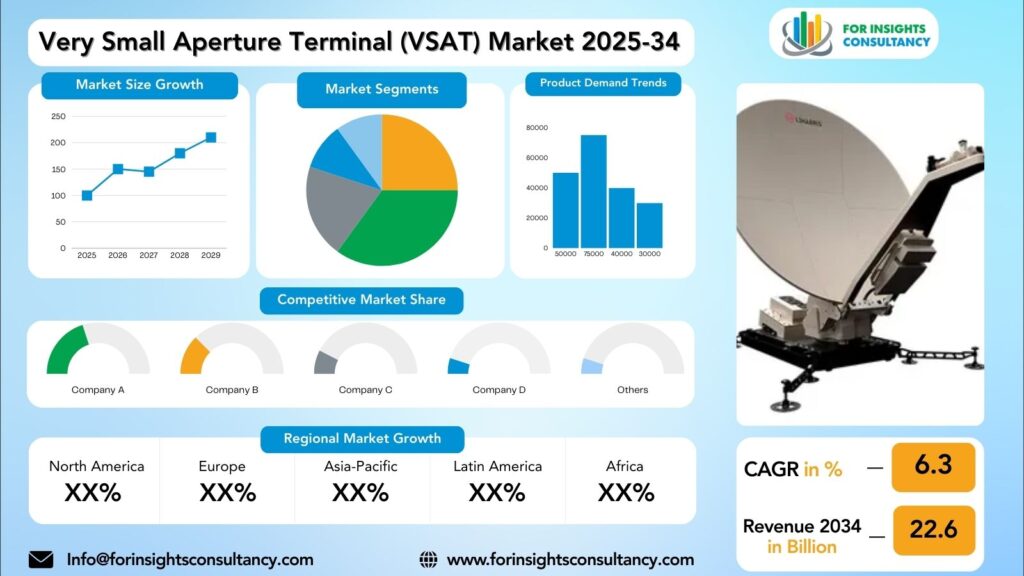
Very Small Aperture Terminal (VSAT) Market Size, Trends Analysis Research Report by Component (Hardware (Antennas, Modems, etc.)), by Services (Connectivity and Support Services), by platform, by frequency band, by End User, and by Region Global Market Analysis and Forecast, 2025-2034
Sep-2025 Formats | PDF | Category: Automotive | Delivery: 24 to 72 Hours
Very Small Aperture Terminal (VSAT) Market is forecast to increase from USD 14.8 Billion in 2025 to USD 22.6 Billion by 2034, at a CAGR of 6.3%.
Very Small Aperture Terminal (VSAT) Market: A Comprehensive Overview and Future Developments
A Very Small Aperture Terminal (VSAT) is a two-way satellite ground station with a dish antenna smaller than 3 meters used to transmit data, voice, and video signals via satellite. It has revolutionized global communication by providing cost-effective and reliable connectivity in remote areas where traditional terrestrial networks are limited or non-existent. Key players in the VSAT market include Hughes Network Systems, Viasat Inc., Gilat Satellite Networks, and Comtech Telecommunications Corp.
The market is expected to experience significant growth in the coming years due to the increasing demand for high-speed internet connectivity in underserved and remote areas. The rise of digital transformation initiatives and the proliferation of IoT devices are also driving the need for robust and scalable satellite communication solutions. The future of the VSAT market looks bright with exciting opportunities, including the deployment of low-earth orbit (LEO) and medium-earth orbit (MEO) satellites, which promise to revolutionize global communication and connectivity.
Very Small Aperture Terminal (VSAT) Market Dynamics
Growth Drivers
The Very Small Aperture Terminal (VSAT) market is experiencing rapid growth due to factors such as increased demand for broadband connectivity, advancements in satellite technology, cost-effective solutions, scalability and flexibility, and rising adoption in emerging markets. VSAT technology is being increasingly used by businesses operating in remote locations and individuals in underserved areas to stay connected.
Advancements in satellite technology have made VSAT systems more efficient and reliable, leading to increased adoption rates and expanded use cases across various industries. VSAT technology offers cost-effective communication solutions, making it a preferred choice for organizations operating in remote or challenging environments where traditional infrastructure may not be available.
VSAT systems are highly scalable, allowing for seamless integration with existing networks and enabling users to expand their communication capabilities as needed. The growing adoption of VSAT technology in emerging markets is driving the market’s expansion, enabling connectivity in remote areas and bridging the digital divide.
VSAT systems have gained the trust of customers across various industries, including maritime, oil and gas, government, and enterprise sectors. Their ability to deliver high-speed connectivity in remote and challenging environments has made them a valuable asset for businesses looking to stay connected and productive. As VSAT technology continues to evolve and expand its reach, it is poised to play a crucial role in shaping the future of communication and connectivity worldwide.
Restraints
The VSAT market, despite its growth potential, faces several challenges. The limited bandwidth capacity of satellite systems can impact the quality and speed of internet connectivity, especially in high-demand areas or data-intensive applications. High initial investment in satellite terminals, ground infrastructure, and service subscriptions can be prohibitive for small businesses and organizations. Regulatory challenges like licensing requirements and spectrum allocation restrictions can also impede the market’s growth. Compliance with local regulations can be complex and time-consuming, creating barriers for VSAT providers looking to expand their operations. Additionally, the emergence of alternative technologies like 5G networks and low Earth orbit satellites poses a competitive threat to the VSAT market, offering faster speeds and lower latency compared to traditional VSAT systems.
Opportunities
VSAT technology can bridge the connectivity gap in emerging markets, providing businesses with the necessary tools to thrive. It also offers a backup solution for disaster recovery, ensuring businesses remain operational during critical times. Additionally, VSAT technology can provide rural connectivity, enabling businesses to reach untapped markets in underserved areas where traditional communication infrastructure may be compromised. Overall, VSAT technology offers a reliable and affordable solution for businesses in these regions.
Challenges
The VSAT market faces several challenges, including navigating regulatory hurdles, staying ahead of technological advancements, and standing out in a crowded market. Companies must navigate complex regulations, such as spectrum allocation and licensing requirements, to ensure compliance and maintain a strong reputation. To stay abreast of regulatory developments and work closely with legal experts, companies can proactively engage with regulators and stay informed.
Technological advancements are also a key challenge, as companies must continually innovate to stay ahead of the curve. By investing in research and development, companies can develop innovative solutions that meet evolving market demands. Collaborating with technology partners and engaging in strategic alliances can help drive business growth.
Competition is fiercer than ever, and companies must differentiate themselves from competitors by offering unique value propositions. By focusing on customer-centric solutions and delivering exceptional service, companies can build a loyal customer base and differentiate themselves from competitors. Investing in marketing and branding initiatives can also help raise awareness of their offerings and attract new customers in a competitive market.
Very Small Aperture Terminal (VSAT) Market Top Companies Covered In This Report:
Evaluate The Strategic Positioning And Innovation Pipelines Of Leading Market Companies-From Multinational Enterprises To Disruptive Regional Firms. Understand How Key Players Are Innovating, Expanding, And Capturing Value, And Use Competitive Benchmarks To Plan Your Next Move.
- General Dynamics Corporation (US)
- Ultra Electronics (UK)
- Honeywell International Inc. (US)
- Orbit Communication Systems Ltd. (Israel)
- L3Harris Technologies Inc (US)
- Viasat Inc. (US)
- Gilat Satellite Networks Ltd. (Israel)
- ST Engineering iDirect, Inc (US)
- Thales Group (France)
- KVH Industries, Inc. (US)
- Singtel (Singapore)
- Mitsubishi Electric Corporation (Japan)
- EchoStar Corporation (US)
- Comtech Telecommunications Corporation (US)
- SatixFy Communications Ltd. (Israel)
Very Small Aperture Terminal (VSAT) Market News
Viasat
In August 2025, Viasat announced a new A$252 million contract with Australia and New Zealand to expand the SouthPAN program, a satellite-based augmentation system. The company also unveiled its “HaloNet” capability portfolio for secure near-Earth communications.
Viasat released its Q1 2026 financial results, which reflected a complex integration process but also new business wins, including a comprehensive agreement with Ligado Networks. The company also reported a decline in consumer subscribers amid stiff competition from low-Earth orbit (LEO) providers.
Hughes Network Systems (EchoStar)
In January 2024, Hughes announced that its Jupiter-3 ultra-high-density satellite had entered commercial service, providing faster speeds and increased capacity for its customers in North and South America.
In June 2024, Hughes partnered with Luna Space Telecommunications in Saudi Arabia to upgrade the country’s VSAT network, which included a new JUPITER™ System Gateway and 1,200 terminals. The company also secured a contract with General Atomics to provide advanced satellite communication technology for its unmanned aircraft systems.
Gilat Satellite Networks
Gilat announced multiple defense contract wins in 2024 and 2025, including a $9.1 million tender from the Israeli Ministry of Defense in December 2024 and a $23 million multi-year contract with the U.S. Department of Defense in April 2025. This highlights a strategic focus on the defense market, which Gilat views as a key growth engine.
The company secured over $18 million in orders for its in-flight connectivity solutions, and its Inmarsat NexusWave service (a Viasat company) exceeded 1,000 vessel orders, indicating strong demand in the maritime sector.
ST Engineering iDirect
In December 2024, the company announced a new technology that enables seamless tracking and switching between Geostationary (GEO) and Non-Geostationary (NGSO) satellites. This innovation, an industry-first, is undergoing testing with a major satellite operator and is a critical step for providing uninterrupted connectivity for mobile platforms like aircraft and ships.
In March 2024, ST Engineering iDirect unveiled its next-generation, cloud-native ground system, “Intuition,” at the Satellite 2024 conference. The system is designed to provide greater scalability, flexibility, and operational efficiency, reducing hardware footprints by up to 70%.
Segmented View of the Industry:
The Equipment segment holds the largest market share due to the high cost of terminals, antennas, and modems. However, the Connectivity Services segment is expected to show the highest growth rate.
The Very Small Aperture Terminal (VSAT) Market Is Mapped Through A Multidimensional Lens-Tracking Shifts Across Product Type, Applications, And Geographic Regions. This Segmented Approach Enables Businesses To Localize Their Growth Plans And Align Offerings With The Most Profitable Demand Centers.
Segmentation by Component
- Hardware
- Services
Segmentation by Platform
- Land VSAT
- Maritime VSAT
- Airborne VSAT
Segmentation by Frequency Band
- Ku-band
- Ka-band
- C-band
- X-band
Segmentation by End-Use Vertical
- Enterprise
- Government & Defense
- Maritime
- Aviation
Global Geographic Coverage:
Based on recent market analysis, North America is the largest and most mature market for Very Small Aperture Terminals (VSAT). Its leading position is driven by significant investments in defense and government sectors and a well-established telecommunications infrastructure.
The Report Provides In-Depth Qualitative and Quantitative Data On the Very Small Aperture Terminal (VSAT) Market For All Of The Regions And Countries Listed Below:
North America
North America is a significant market for VSAT solutions due to its technological advancements and high internet penetration rates. The United States and Canada dominate the North American VSAT market, offering cutting-edge solutions for industries like telecommunications, oil and gas, maritime, and government.
The US leads the way in adopting VSAT technology, offering solutions for enterprise connectivity and disaster recovery.
Canada, on the other hand, focuses on providing secure and reliable communication services for industries like mining, forestry, and agriculture. The region’s advanced technological landscape and diverse industry verticals create opportunities for VSAT providers to innovate and expand their offerings. Overall, North America presents a lucrative market for VSAT solutions, driven by the growing emphasis on digital connectivity and communication infrastructure.
Europe
Europe is a major player in the global VSAT market, with several countries driving innovation and growth. Germany, known for its technological prowess, is a significant market for VSAT solutions, focusing on digital connectivity and smart infrastructure. VSAT plays a vital role in ensuring reliable and high-speed data transmission in various sectors, including maritime industries. The United Kingdom is also a key market for VSAT services, particularly in maritime, oil and gas, and government sectors.
The UK’s commitment to digital transformation and infrastructure development solidifies its position in the global VSAT market. France is another European country at the forefront of VSAT innovation, focusing on satellite communication solutions. The country’s diverse landscape and varied industries present unique challenges that can be effectively addressed through VSAT technology. France continues to leverage VSAT solutions for increased efficiency and reliability in communication networks. In conclusion, Europe’s VSAT market is driven by countries like Germany, the United Kingdom, and France, which are advancing connectivity, improving data transmission, and supporting critical infrastructure.
Asia Pacific
The Very Small Aperture Terminal (VSAT) market in the Asia Pacific region is experiencing significant growth due to the increasing demand for high-speed internet connectivity in remote areas. China, India, Japan, South Korea, and Australia are key players in this market, driven by their advanced telecommunications infrastructure, technological innovations, and strong focus on research and development. India’s adoption of VSAT technology in sectors like telecom, banking, and agriculture is driving the market’s growth.
Japan’s mature VSAT market is also thriving, driven by its advanced telecommunications infrastructure and investment in satellite technology. South Korea’s VSAT market is rapidly expanding due to its demand for reliable and high-speed connectivity. Australia’s VSAT market is experiencing steady growth due to its vast landscape and dispersed population, making it an ideal solution for connecting businesses and communities.
Middle East and Africa
The Very Small Aperture Terminal (VSAT) market is experiencing robust growth in the Middle East and Africa due to increasing connectivity demands and technological advancements. Countries like Saudi Arabia, the UAE, and Qatar are leading this growth, driven by the need for high-speed internet connectivity in remote areas. Government initiatives and infrastructure development projects are paving the way for continued expansion. Africa presents a unique market opportunity for VSAT providers, with countries like Nigeria, South Africa, and Kenya showing interest in leveraging VSAT technology to improve connectivity in rural areas. As regulatory frameworks evolve and investments in the telecommunications sector continue, the future looks promising for the VSAT industry in these regions.
Reasons to Buy:
- The Research Would Help Top Administration/Policymakers/Professionals/Product Advancements/Sales Managers And Stakeholders In This Market In The Following Ways.
- The Report Provides Very Small Aperture Terminal (VSAT) Market Revenues At The Worldwide, Regional, And Country Levels With A Complete Analysis To 2034 Permitting Companies To Analyze Their Market Share And Analyze Projections, And Find New Markets To Aim For.
- To Understand The Most Affecting Driving And Restraining Forces In The Market And Their Impact On The Global Market.
- Major Changes And Assessment In Market Dynamics And Developments.
- The Objective Of The Very Small Aperture Terminal (VSAT) Market Report Is To Identify New Business Opportunities Using Quantitative Market Forecasts.
- Formulate Sales And Marketing Strategies By Gaining An Understanding Of Competitors, Their Positioning, And Strengths & Weaknesses.
Faq – What Global Leaders Are Asking
What Is The Growth Prospect For The Very Small Aperture Terminal (VSAT) Market By 2034?
Very Small Aperture Terminal (VSAT) Market Is Expected To Achieve A Stable Growth Rate With A Compound Annual Growth Rate (Cagr) Of About 6.3% From 2025 Through 2034.
What Is Driving The Growth Of The Very Small Aperture Terminal (VSAT) Market?
The growth of the VSAT market is driven by the increasing demand for high-speed, reliable connectivity in remote and underserved locations, especially across the maritime, aviation, and defense sectors. This is further fueled by the proliferation of High-Throughput Satellites (HTS) and Low-Earth Orbit (LEO) constellations, which are reducing costs and improving performance.
Who Are The Key Players In The Very Small Aperture Terminal (VSAT) Market, And What Are Their Market Shares?
The Very Small Aperture Terminal (VSAT) Market Includes Major Companies Like General Dynamics Corporation (US), Ultra Electronics (UK), Honeywell International Inc. (US), Orbit Communication Systems Ltd. (Israel), L3Harris Technologies Inc (US), Viasat Inc. (US), Gilat Satellite Networks Ltd. (Israel), ST Engineering iDirect, Inc (US), Thales Group (France), KVH Industries, Inc. (US), Singtel (Singapore), Mitsubishi Electric Corporation (Japan), EchoStar Corporation (US), Comtech Telecommunications Corporation (US), SatixFy Communications Ltd. (Israel), Others.
Specific Market Share Data Is Not Publicly Available and Is Typically Provided In Detailed, Proprietary Market Research Reports.
Which Regions Are Leading the Very Small Aperture Terminal (VSAT) Market Growth?
While some market analysis shows North America as the largest market, the Asia-Pacific region is the clear leader in growth. This growth is fueled by massive government-backed initiatives, particularly in China and India, aimed at bridging the digital divide in remote areas.
Customization: We Can Provide Following Things
1) On Market More Company Profiles (Competitors)
2) Data About Particular Country Or Region
3) We Will Incorporate The Same With No Additional Cost (Post Conducting Feasibility).
Any Requirement Contact Us: Https://Www.Forinsightsconsultancy.Com/Contact-Us/
Table of Contents
For TOC Contact us: https://forinsightsconsultancy.com/contact-us/







